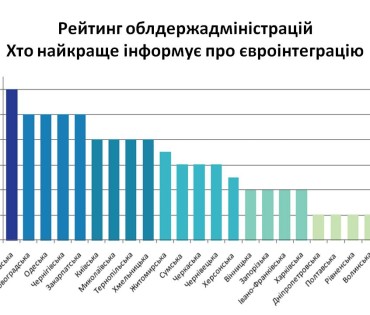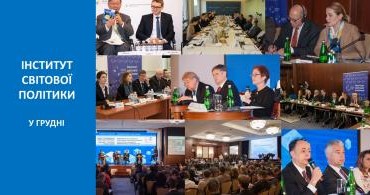A policy brief prepared by Daria Gaidai, analyst of the Institute of World PolicyPlease click here to download the full pdf version.
Increasing the level of support for European integration course among the residents of Ukrainian regions would contribute greatly to success of any reform. Thus far, a significant contribution for the coverage of issues related to European integration has been carried out by non-governmental organizations, the EU Delegation and representatives of the EU member states; however, with the start of the Association Agreement implementation and introduction of a free trade area (since January 1, 2016), the primary responsibility for public awareness moves to Ukrainian authorities. Development of a clear and thorough information strategy should become a priority of state policy in the field of European integration.
However, Ukrainian politicians and experts, though recognizing the need to raise public awareness on European integration, often forget about the role of local authorities in this process, although the latters have multiple tools to influence public opinion at their disposal. By neglecting, either consciously or unconsciously, the issues related to European integration, the local officials would undermine the central government’s efforts and hamper the implementation of state policy in this direction. Moreover, the process of decentralization implies significant empowerment of the local authorities, which would make them share responsibility for the Europeanization of Ukraine with the central government.
What is the role of the regional state administrations in the European choice promotion on a regional level nowadays? How effective are they in informing the citizens on the advantages and possibilities of cooperation with the EU? How is the process of European integration perceived on a regional level? In order to answer these questions, we have been conducting a monitoring of the regional state administrations’ websites in terms of their coverage of the European integration process from September 14 to September 20, 2015. Taking into account the complications in Donetsk and Luhansk regions due to loss of Ukrainian government’s control over some areas of these regions, these two regions, as well as Crimea, occupied by the Russian Federation, were excluded from our monitoring. We evaluated the content of the websites based on a number of criteria: availability of general information on EU-Ukraine cooperation, information on regional events/activities/initiatives related to European integration, availability of practical recommendations for producers willing to export their products to the EU (or references to the relevant resources), and publication of the regional Association Agreement implementation action plan and report on the plan’s execution for 2014.
Informational leaders and outsiders
According to the action plan for the implementation of the Association Agreement between Ukraine and the EU for 2014 – 2017, approved by the Cabinet of Ministers of Ukraine on September 17, 2014, the central and local executive authorities should provide the public and media access to relevant information on the Association Agreement implementation on a permanent basis (Article 470). Achieving this goal involves „setup, maintenance and updating the relevant sections of the official websites of local executive authorities on a regular basis.“ Following the Cabinet of Ministers’ instructions, the regional state administrations have developed and approved regional Association Agreement implementation action plans for 2014 – 2017 including the public awareness activities.
It should be noted that setting up separate pages related to European integration on the websites of executive authorities has been outlined by the State target program for increasing the public awareness on European integration for 2008-2011. This program required active involvement of local authorities in the process of informing the citizens of Ukraine on the practical possibilities of using the results of cooperation with the EU. However, as shown by our monitoring, a number of regional state administrations’ do not update the information inside the sections “European integration” or “European choice”.
For instance, no data regarding European integration could be found on the web resources of Dnipropetrovsk, Poltava, and Volyn regions. The websites of Rivne and Kharkiv Regional State Administrations contained only the hopelessly outdated information. Latest press releases and news regarding European integration on Kharkiv Regional State Administration website date back to 2010, while the regulatory documents have time stamps of 2008. To be objective, we should note that in 2015, a post on Kharkiv region’s participation in the Association of European Border Regions has been added; however, it did not contain any details. Rivne Regional State Administration’s website hasn’t had its section on European integration updated since 2012.
The internet pages of Khmelnytsky, Vinnytsia, Zaporizhzhia, Ivano-Frankivsk, Kherson and Sumy regions contain only general information on the EU (history, institutions, and member states), Ukraine’s relations with the EU, and the
Association Agreement. Moreover, the information on some of these websites has not been updated at least since last year, and the latest news includes only the Europe Day celebration in 2015.
The web pages of Kyiv, Mykolaiv, Ternopil, Cherkasy, and Chernivtsi regional state administrations show relatively better situation with their content. Information on the provisions and implementation of the Association Agreement and the free trade zone with the EU is more detailed; furthermore, which should be emphasized, the websites of these regions contain practical guides for regional exporters and producers interested in entering the European market. For instance, Mykolaiv RSA web page offers the „Endowment resources and investments in regional development for 2015“ manual, as well as the „Map of international technical assistance.“ The issues of trade and economic cooperation between Ukraine and the EU are also covered in details on Kyiv RSA website. However, those resources are lacking relevant information on the regional dimension of European integration process. Specifically, the latest news on Sumy RSA web page Date back to 2014.
The top five of our rating features the web pages of Lviv, Zakarpattia, Kyrovohrad, Odesa and Chernihiv RSAs. The web resources of those regional state administrations one could not only find relevant information on EU-Ukraine cooperation or the Association Agreement implementation (often as the links to the Government’s resources), but also learn about projects, initiatives and activities related to European integration on the regional level. As a positive example, we could mention the „Economic Portal“ created by the Department of Economic Development of Chernihiv Regional State Administration containing comprehensive information on the terms of exporting goods and services to the EU, current news, announcements, programs and grants. The Kyrovohrad RSA’s website also offers the latest news on the events associated with European integration and regional initiatives. However, almost all of them are related to cooperation in the cultural and educational spheres or popularizing European integration among the region’s residents.
{3}
Quite comprehensive public awareness campaign is being conducted by the Department of Foreign Economic Activity and European Integration of Odessa Regional State Administration. The dedicated web page of the Department features not only the latest information on cooperation between Ukraine and the EU, but also news by the EU Delegation in Ukraine and articles on European integration issues. However, this resource is also lacking systematic approach to the coverage of the regional dimension of European integration, as among all conducted events, only the Europe Day celebration is listed. All other news on events associated with European integration are placed in the general news feed, which makes it fundamentally difficult to obtain the objective and comprehensive picture of European integration processes in the region. The easiest way to improve the situation would be publishing of quarterly (or semiannual) reports on the local authorities’ activities in this regard.
{4}
Among the top five, only Lviv regional administration’s website contained the regional Association Agreement implementation action plan, as well as the report on its execution for 2014. Moreover, instead of lengthy articles on cooperation between Ukraine and the EU, the website of our rating’s leader included clear and vivid infographics and links to key information materials on European integration and basic guide to business internationalization and access to the EU’s markets. Furthermore, the Facebook page of the regional state administration’s Department of Economic Development, Trade and Industry offers relevant information regarding events related to cooperation with European structures, infographics, and other materials updated on a regular basis.
It should be noted that in our assessment of the coverage of European integration process, our primary focus was not on the amount of posted information, but on its importance and relevance. Lengthy articles on relations between Ukraine and the EU (or on history of the EU) do not facilitate a clear understanding of impact of European integration process on the quality of life in respective region.
The local authorities’ information resources should be, on the one hand, a source of comprehensive and systematic information on the process of European integration in a specific region for the local media and the public (not only a repeater of the Government’s messages); and on the other hand, a kind of a database for regional businesses interested in trading with the EU. As shown by our monitoring, currently the regional administrations display certain success only in the second item. It is natural, taking into account that coordination and aggregation of the activities aimed at execution of the regional action plan are imposed on the „economic“ departments of the regional state administrations responsible for foreign economic activities and economic development.
The full version of policy brief is available here.
This policy brief has been developed awithin the “Initiative for Development of Ukrainian Think Tanks” conducted by the International Renaissance Foundation (IRF) in association with the Think Tank Fund (TTF) with financial support of the Swedish embassy in Ukraine (SIDA).




Comments theme
Comments themeComments themeComments themeComments themeComments themeComments themeComments themeComments themeComments themeComments themeComments themeComments themeComments themeComments themeComments themeComments themeComments themeComments themeComments themeComments.